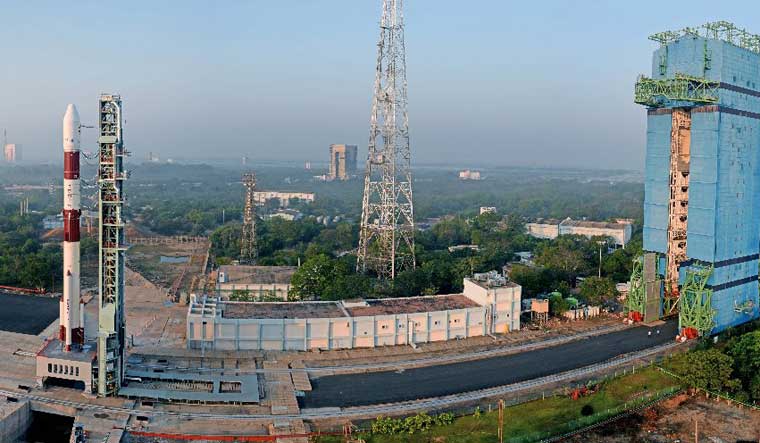The Indian Space Research Organisation (ISRO) is presently conducting research and studies and is also conducting projects to enable the vertical landing of its rockets—primarily the GSLV Mk-III is expected to benefit ISRO immensely as per space experts. Experts observe that for GSLV Mk-II and Mk-III being medium to heavy class launch vehicles, reusability will be a key technology to demonstrate, so that cost can be drastically brought down and ISRO can be more competitive in the global landscape.
Currently, ISRO’s rockets are expendable and the rocket stages separate from the launch vehicle and fall into the sea after their burn time. Reusability can help in recovering the rocket’s stages at sea or on land by vertical landing and then bring them back for flying after refurbishing, servicing and testing them.
ISRO already has an ongoing programme to first try a technology demonstrator to recover the L40 strap-on boosters from GSLV Mk-II. “The technology involved is complex – it’s just like shooting an arrow aiming at the bullseye a few hundred kilometres, the main difference being the bulls eye is not stationary, as the earth is rotating. The prerequisites in terms of inertial navigation and guidance is something ISRO already has an expertise in. It is only a matter of decision making and iterations to enable reuse of launch vehicles,” Rohan M. Ganapathy, CEO and CTO of Bellatrix Aerospace told THE WEEK.
This expert further explained that rockets are complex things to produce as when one sees a rocket launch, one sees it as a single piece going upwards. However, it has millions of components that have to work in synchronisation. “There are millions of rocker components that take time to manufacture and it is not like in the automobile industry where it can be rolled down. The production line cannot be speeded up very quickly. When there is so much demand for regular launches, reuse is the best option, similar to airplanes. If one orders an airplane, it takes two to three years for delivery. Building rockets is similar. Since we reuse airplanes, we are able to meet passenger traffic and budgets. Similar analogy applies for rockets. Another advantage of reusability is that the pressure on the industry comes down, ensuring 100 percent reliable launches,” added Ganapathy.
Experts observe that GSLV Mk-III is little different from other rockets in the sense that first stage boosters use solid propellants and for the second stage, ISRO could try landing similar to Falcon 9 by reigniting the engine with spare fuel. However, solid rocket boosters are simple metal shells in which the solid propellant is loaded, but since they are massive structures, they could be recovered using parachutes, similar to how space shuttle boosters were recovered. The second stage has a semi cryogenic engine. To reuse this, ISRO has to first demonstrate entry, descent and landing (EDL) first with the L40 boosters of Mk-II and once established, can be mastered on Mk-III. Together, GSLV Mk-II and Mk-III will cater to the medium to heavy launch market. “By increasing the launch vehicle frequency, we can aim at becoming more cost competitive than SpaceX considering our economics and approach to engineering. It is not just Mk-II and Mk-III—ISRO is also looking one step further for their Single Stage to Orbit vehicle, Avatar programme, which will enable more efficient access to orbit,” said Ganapathy.
ALSO READ
- Why is specialised coating essential for the delayed NISAR mission’s antenna?
- 'Pushpak': All you need to know about ISRO's RLV and its successful landing
- Why ISRO has pinpointed 48 locations for safe return of Gaganyaan astronauts
- S. Somnath says his family was 'shocked' after cancer diagnosis on Aditya-L1 launch day
Since GSLV Mk-III is one of ISRO's most advanced and capable launch vehicles, particularly used for sending heavyweight communication satellites, interplanetary missions, and soon human missions reusability can be a very significant factor. “SpaceX. Falcon 9’s staging is simple since it is a two stage vehicle whereas Mk-III is a complex vehicle with two boosters and a liquid core engine and cryogenic engine. It might be comparatively more complex to land than Falcon 9 if we are also thinking about recovering the boosters, but it would be a great technological improvement. We think that the first step to achieving this would be having accurately throttleable Kerlox engines for the core stage, and also we think we can use parachute based recovery for solid rocket motors, like what NASA used to do for space shuttle boosters. Since India has its own Navigation Satellite System NaVIC, it might add additional benefits in navigating the rocket back to the location and achieve a higher accuracy landing.
We think that capabilities like this would not just help us in reducing the cost and overall economy of the launches but also make us technologically advanced and help us in practicing landing which we need to do when we are doing interplanetary missions, it would also be an immensely proud moment for the country,” pointed out Srimathy Kesan, the founder and CEO of Space Kidz India.
Many space experts also feel that reuse is the future of all heavy lift launch vehicles and will help reduce costs and also push the boundaries of reliability resulting in safer missions. “There will be a payload penalty which can be addressed through right augmentation. SpaceX of the USA has achieved 90 percent successful landings of orbital vehicle stages and China and Russia are aggressively pursuing reusable vehicles,” said Pawan Kumar Chandana, co-founder and CEO, Skyroot Aerospace.





